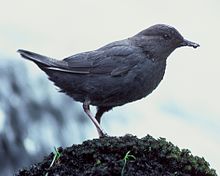Dippers
| Dippers | |
|---|---|
 |
|
| American dipper | |
| Scientific classification | |
| Kingdom: | Animalia |
| Phylum: | Chordata |
| Class: | Aves |
| Order: | Passeriformes |
| Suborder: | Passeri |
| Family: |
Cinclidae Sundevall, 1836 |
| Genus: |
Cinclus Borkhausen, 1797 |
| Species | |
Dippers are members of the genus Cinclus in the bird family Cinclidae, named for their bobbing or dipping movements. They are unique among passerines for their ability to dive and swim underwater.
Dippers are small, chunky, stout, short-tailed, short-winged, strong-legged birds. The different species are generally dark brown (sometimes nearly black), or brown and white in colour, apart from the rufous-throated dipper, which is brown with a reddish-brown throat patch. Sizes range from 14–22 cm in length and 40–90 g in weight, with males larger than females. Their short wings give them a distinctive whirring flight. They have a characteristic bobbing motion when perched beside the water, giving them their name. While under water, they are covered by a thin, silvery film of air, due to small bubbles being trapped on the surface of the plumage.
Dippers are found in suitable freshwater habitats in the highlands of the Americas, Europe and Asia. In Africa they are only found in the Atlas Mountains of Morocco. They inhabit the banks of fast-moving upland rivers with cold, clear waters, though, outside the breeding season, they may visit lake shores and sea coasts.
Unlike many water birds, dippers are generally similar in form to many terrestrial birds (for example they do not have webbed feet), but they do have some morphological and physiological adaptations to their aquatic habits. Their wings are relatively short but strongly muscled, enabling them to be used as flippers underwater. To reduce their buoyancy in water, the bones are solid instead of hollow. They have dense plumage with a large preen gland for waterproofing their feathers. Relatively long legs and sharp claws enable them to hold on to rocks in swift water. Their eyes have well-developed focus muscles that can change the curvature of the lens to enhance underwater vision. They have nasal flaps to prevent water entering their nostrils.
Their blood has a high haemoglobin concentration, allowing a greater capacity to store oxygen than terrestrial birds, and allowing them to remain underwater for up to at least thirty seconds, whilst their basal metabolic rate is approximately one-third slower than typical terrestrial passerines of similar mass. One small population wintering at a hot spring in Suntar-Khayata Mountains of Siberia feeds underwater when air temperatures drop below −55 °C (−67 °F).
...
Wikipedia
